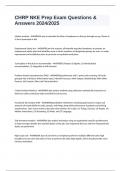CHRP NKE Prep Exam Questions &
Answers 2024/2025
Markov analysis - ANSWERSA way to calculate the flow of employees as they go through an org. Shows in
% the # promoted or left
Employment Equity Act - ANSWERSLaw that requires all federally regulated employers to prepare an
employment equity plan that identifies areas in which members of designated groups are over- or under-
represented and establishes plans to promote an equitable work place
3 principles of the duty to accommodate - ANSWERS1) Respect & dignity, 2) individualized
accommodation, 3) integration & full inclusion
Position Analysis Questionnaire (PAQ) - ANSWERSQuestionnaire with 5 point scale covering 194 tasks,
grouped into 6 divisions (Information Input, Mental Processes, Work Output, Relationships With Other
Persons, Job Context, Other Job Characteristics).
Critical Incident Method - ANSWERSA job analysis method using collection methods like interviews or
diaries to collect critical job tasks essential for job success.
Functional Job Analysis (FJA) - ANSWERSQuantitative method for classifying jobs based on types and
amounts of responsibility for data, people, and things along with performance standards and training
requirements. Uses seven scales to describe what workers do in jobs: (1) Things, (2) Data, (3) People, (4)
Worker Instructions, (5) Reasoning, (6) Math, and (7) Language.
Task Inventory Analysis - ANSWERSA job analysis technique using an organization specific questionnaire
to help ees/mgrs identify the essential duties of the job, how important they are and how frequently the
duties are performed
High Scope Job - ANSWERSA type of job where an employee performs multiple different tasks (high
breadth) and can exert discretion in how to perform the tasks (high depth), which should provide more
intrinsic motivation.
,Low Scope Job - ANSWERSA type of job that performs single/repetitive tasks with no discretion (low in
breadth and depth)
Job Enrichment - ANSWERSEnhancing a job by adding more meaningful tasks and duties (vertical
expansion/loading) to make the work more rewarding or satisfying (Frederick Herzberg)
Job Enlargement - ANSWERSHorizontal loading of a job. To increase volume or variety of tasks. (Frederick
Herzberg)
Motivator-Hygiene theory (aka Two factor theory) - ANSWERSHerzberg's theory that ees are primarily
motivated by growth and esteem needs, not lower-level needs. Largely rejected by studies but helped
contribute to the job characteristics model
Job Characteristics Model - ANSWERSHackman and Oldham's job design theory that identifies five core
job dimensions (skill variety, skill identity, skill significance, automony, job feedback) that prompt three
psychological states (meaningfulness, has responsibility for work outcome, knows how well they are
doing) which, in turn, lead to or have an effect on five work-related outcomes or results (internal
motivation, growth, general job satisfaction, work effectiveness).
Realistic Job Preview (RJP) - ANSWERSInforming candidates about all aspects of the job, including both
its desirable and undesirable facets (positives: improved ee satisfaction, reduced voluntary turnover,
enhanced communication through honesty and openness, realistic job expectations, reduce potential
legal action for misrepresentation/fraud).
Dual Career Path - ANSWERSWhen a professional moving up to specialist is given the same rewards as a
move to management
Career Plateaus - ANSWERSTypes include: Structural (end of advancement), most common= content
(lack of challenge, stifled by the jobs content), life (mid-life crisis)
Reliability - ANSWERSThe degree to which interviews, tests and other selection procedure yield
comparable data over time
, Validity - ANSWERSThe degree to which a test or selection procedure measures a person's attribute. The
accuracy with which a predictor measures what it is intended to measure.
Big 5 Personality Traits - ANSWERS1) Extroversion, 2) Agreeableness, 3) Conscientiousness, 4)
Neuroticism/emotional stability, 5) Openness to experience
Criterion-related validity - ANSWERSThe extent to which a selection tool predicts work behaviour, or
significantly correlates with important elements of work behaviour
Concurrent Validity - ANSWERSThe extent to which test scores (or other predictor information) match
criterion data obtained at about the same time from current employees
Predictive Validity - ANSWERSThe extent to which applicant's test scores match criterion data obtained
from those applicants after they have been on the job for some indefinite period
Construct Validity - ANSWERSThe extent to which a selection tool measures a theoretical construct or
trait like intelligence, verbal skills, analytical ability and leadership skills. Difficult to validate (ie creative
arts tests, honesty tests)
Differential validity - ANSWERSConfirmation that the selection tool accurately predicts the performance
of all possible ee subgroups (inc white males, visible minorities, persons with disabilities, women,
aboriginal people)
Validity generalization - ANSWERSThe extent to which validity coefficients can be generalized across
situations
Content Validity (Face validity) - ANSWERSThe extent to which a selection instrument adequately
samples the knowledge and skills needed to perform a particular job (typing tests for admin, drivers test
for drivers)
Qualified privilege - ANSWERSLegal concept: If fair, honest and candid references are given the
reference-giver is protected from litigation even if negative info is shared




